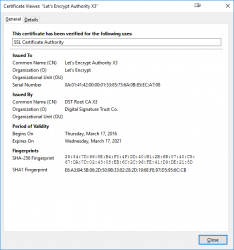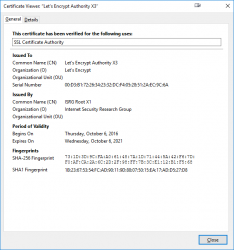Let's Encrypt Transitioning to ISRG's Root
Sunday, May 5. 2019
Over an year ago, I posted a piece regarding Let's Encrypt and specifically me starting to use their TLS certificates. This certificate operation they're running is bit weird, but since their price for a X.509 cert is right (they're free-of-charge), they're very popular (yes, very very popular) I chose to jump into their wagon.
In my previous post I had this flowchart depicting their (weird) chain of trust:
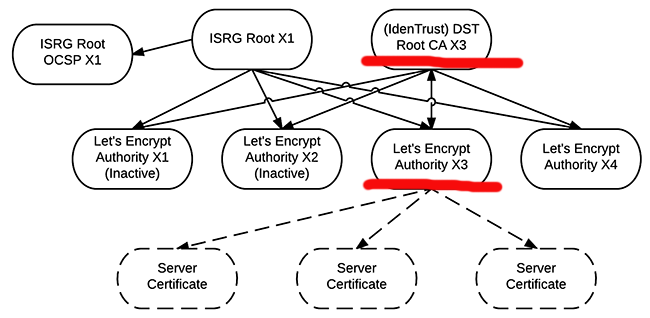
I'm not going to repeat the stuff here, just go read the post. It is simply weird to see a CHAIN of trust not being a chain. Technically a X.509 certificate can be issued by only one issuer, not by two.
Last month they announced, they're going this way:
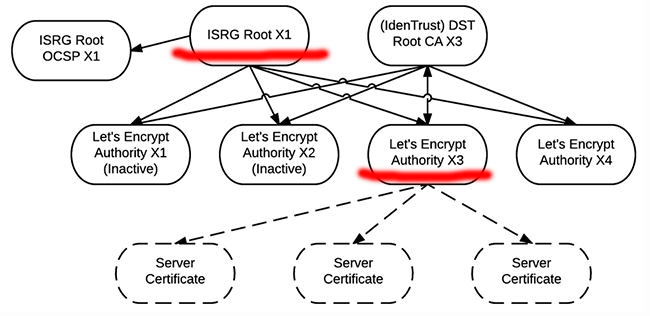
What is this change and how will it affect me?
Read the announcement at https://letsencrypt.org/2019/04/15/transitioning-to-isrg-root.html. There is a very good chance, it will not affect you. Its more like a change in internal operation of the system. The change WILL take place on 8th of July this year and any certificates issued by users like me and you will originate from a new intermediate CA using a certificate issued by ISRG's own CA. So, the change won't take place instantly. What will happen is, for the period of 90 days (the standard lifetime of a Let's Encrypt certificate) after 8th July, sites will eventually transition to these new certificates.
The part where it might have an impact to you is with legacy devices, browsers, operating systems, etc. Especially, if you're one of the unhappy legacy Android mobile users, it WILL affect you. Lot of concerned people are discussing this change at https://community.letsencrypt.org/t/please-reconsider-defaulting-to-the-isrg-root-its-unsupported-by-more-than-50-of-android-phones/91485. If you're smart enough to avoid those crappy and insecure 'droids not having any security patches by a mobile vendor who doesn't care about your security, then this will not affect you.
Testing - A peek into the future
The way Let's Encrypt does their business is weird. I have stated that opinion a number of times. However, as they are weird, they are not incompetent. A test site has existed for a long time at https://valid-isrgrootx1.letsencrypt.org/, where you can see what will happen after July 8th 2019.
On any browser, platform or device I did my testing: everything worked without problems. List of tested browsers, platforms and devices will include:
- Anything regular you might have on your devices
- Safari on multiple Apple iOS 12 mobile devices
- Chrome on Huawei Honor P9 running Android 8
- Microsoft Edge Insider (the Chrome-based browser)
- Safari Technology Preview (macOS Safari early release branch)
- Firefox 66 on Linux
- Curl 7.61 on Linux
An attempt to explain the flowchart
Yes, any topic addressing certificates, cryptography and their applications is always on the complex side of things. Most likely this explanation of mine won't clarify anything, but give me some credit for trying. ![]()
In an attempt to de-chiper the flowchart and put some sense to a chain-not-being-a-chain-but-a-net, let's take a look into the certificate chain details. Some things there are exactly the same, some things there are completely different.
Chain for an old certificate, issued before 8th July
Command: openssl s_client -showcerts -connect letsencrypt.org:443
Will output:
CONNECTED(00000003)
---
Certificate chain
0 s:CN = www.letsencrypt.org
i:C = US, O = Let's Encrypt, CN = Let's Encrypt Authority X3
-----BEGIN CERTIFICATE-----
MIIHMjCCBhqgAwIBAgISA2YsTPFE5kGjwkzWw/oSohXVMA0GCSqGSIb3DQEBCwUA
...
gRNK7nhFsbBSxaKqLaSCVPak8siUFg==
-----END CERTIFICATE-----
1 s:C = US, O = Let's Encrypt, CN = Let's Encrypt Authority X3
i:O = Digital Signature Trust Co., CN = DST Root CA X3
-----BEGIN CERTIFICATE-----
MIIEkjCCA3qgAwIBAgIQCgFBQgAAAVOFc2oLheynCDANBgkqhkiG9w0BAQsFADA/
...
KOqkqm57TH2H3eDJAkSnh6/DNFu0Qg==
-----END CERTIFICATE-----
---
Server certificate
subject=CN = www.letsencrypt.org
issuer=C = US, O = Let's Encrypt, CN = Let's Encrypt Authority X3
...
Chain for a new certificate, issued after 8th July
Command: openssl s_client -showcerts -connect valid-isrgrootx1.letsencrypt.org:443
Will output:
CONNECTED(00000003)
---
Certificate chain
0 s:CN = valid-isrgrootx1.letsencrypt.org
i:C = US, O = Let's Encrypt, CN = Let's Encrypt Authority X3
-----BEGIN CERTIFICATE-----
MIIFdjCCBF6gAwIBAgISA9d+OzySGokxL64OccKNS948MA0GCSqGSIb3DQEBCwUA
...
yEnNbd5O8Iz2Nw==
-----END CERTIFICATE-----
1 s:C = US, O = Let's Encrypt, CN = Let's Encrypt Authority X3
i:C = US, O = Internet Security Research Group, CN = ISRG Root X1
-----BEGIN CERTIFICATE-----
MIIFjTCCA3WgAwIBAgIRANOxciY0IzLc9AUoUSrsnGowDQYJKoZIhvcNAQELBQAw
...
rUCGwbCUDI0mxadJ3Bz4WxR6fyNpBK2yAinWEsikxqEt
-----END CERTIFICATE-----
---
Server certificate
subject=CN = valid-isrgrootx1.letsencrypt.org
issuer=C = US, O = Let's Encrypt, CN = Let's Encrypt Authority X3
...
But look the same!
Not really, looks can be deceiving. It's always in the details. The important difference is in level 1 certificate, having different issuer. Given cryptographny, the actual bytes transmitted on the wire are of course different as any minor change in a cert details will result in a completely different result.
As a not-so-important fact, the level 0 certificates are complately different, because they are for different web site.
Then again the level 1 certs are the same, both do have the same private key. There is no difference in the 2048-bit RSA modulus:
Certificate:
Data:
Issuer: C = US, O = Internet Security Research Group, CN = ISRG Root X1
Subject: C = US, O = Let's Encrypt, CN = Let's Encrypt Authority X3
Subject Public Key Info:
Public Key Algorithm: rsaEncryption
RSA Public-Key: (2048 bit)
Modulus:
00:9c:d3:0c:f0:5a:e5:2e:47:b7:72:5d:37:83:b3:
68:63:30:ea:d7:35:26:19:25:e1:bd:be:35:f1:70:
92:2f:b7:b8:4b:41:05:ab:a9:9e:35:08:58:ec:b1:
2a:c4:68:87:0b:a3:e3:75:e4:e6:f3:a7:62:71:ba:
79:81:60:1f:d7:91:9a:9f:f3:d0:78:67:71:c8:69:
0e:95:91:cf:fe:e6:99:e9:60:3c:48:cc:7e:ca:4d:
77:12:24:9d:47:1b:5a:eb:b9:ec:1e:37:00:1c:9c:
ac:7b:a7:05:ea:ce:4a:eb:bd:41:e5:36:98:b9:cb:
fd:6d:3c:96:68:df:23:2a:42:90:0c:86:74:67:c8:
7f:a5:9a:b8:52:61:14:13:3f:65:e9:82:87:cb:db:
fa:0e:56:f6:86:89:f3:85:3f:97:86:af:b0:dc:1a:
ef:6b:0d:95:16:7d:c4:2b:a0:65:b2:99:04:36:75:
80:6b:ac:4a:f3:1b:90:49:78:2f:a2:96:4f:2a:20:
25:29:04:c6:74:c0:d0:31:cd:8f:31:38:95:16:ba:
a8:33:b8:43:f1:b1:1f:c3:30:7f:a2:79:31:13:3d:
2d:36:f8:e3:fc:f2:33:6a:b9:39:31:c5:af:c4:8d:
0d:1d:64:16:33:aa:fa:84:29:b6:d4:0b:c0:d8:7d:
c3:93
New certificate from a GUI
Obviously, the same thing can be observed from your favorite browser. Not everybody loves doing most of the really important things from a command-line-interface.
Completely different. Same, but different.
Confusion - Bug in Firefox
Chrome, correctly displaying DST-root for www.letsencypt.org:
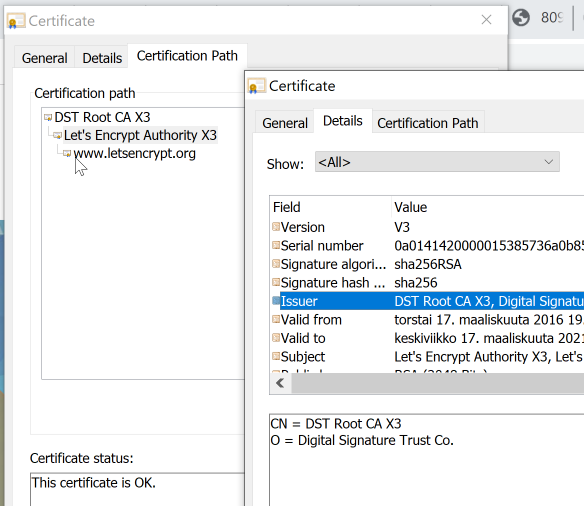
Firefox failing to follow the certificate chain correctly for the same site:
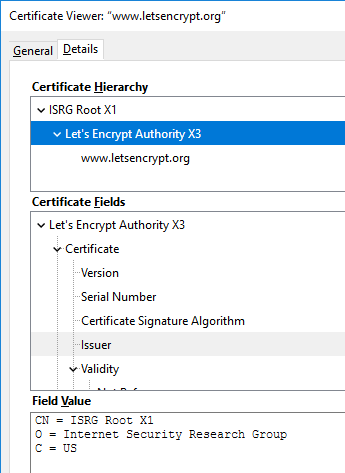
This is the stuff where everybody (including me) gets confused. Firefox fails to display the correct issuer information! For some reason, it already displays the new intermediate and root information for https://letsencrypt.org/.
Most likely this happens because both of the intermediate CA certificates are using the same private key. I don't know this for sure, but it is entirely possible, that Mozilla TLS-stack is storing information per private key and something is lost during processing. Another explanation might be, that lot of Mozilla guys do work closely with Let's Encrypt and they have hard-coded the chain into Firefox.
Finally
Confused?
Naah. Just ignore this change. This is Internet! There is constantly something changing. ![]()
What's inside a credit card
Friday, May 3. 2019
Most of us have a credit card (or debit) for payment purposes. As I love tech, technically speaking, it is laminated polyvinyl chloride acetate (PVCA) piece of plastic conforming to ISO/IEC 7810 ID-1.
What's in a card is:
- The standard-compliant plastic frame
- ISO/IEC 7816 smart card with 8-pin connector
- ISO/IEC 14443 RFID chip and antenna for contactless payments
- (optional, deprected as insecure) ISO/IEC 7811, 7812 and 7813 compliant magnetic strip
The reason I got interested about this begun when I got a new debit card. Anybody having one of these cards know, that they do expire eventually. My bank sends me new one roughly one month before expiry, at which point I tend to destroy the old one into very small pieces to avoid some garbage digging person to be able to exploit my information.
This time, I took couple of pictures of it first (then I destroyed it) to publish in the Internet.
Waitaminute!
You're not supposed to post an image of your credit card! See https://cheezburger.com/8193250816 for a my-new-credit-card fail.
No, I'm not going to do that, instead:

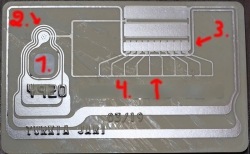
Notice how couple years of usage made the card crack and laminated back and top parts of the card started peeling off. The lamination process failed somehow. Maybe the superglue wasn't super enough, or something similar. I've never seen such a thing happen before.
Here goes: I publicly posted pictures of my old debit card! Obviously, before doing that, I redacted my card number. Also, I'm not going to publish image of the back side having the CVC validation number and my signature. For those curious why I din't redact all 16 digits, the first four are not that important, because its kinda obvious the card is a Visa (first digit 4) and in Finland all Visa cards are issued by Nets Oy (formerly Luottokunta). For card numbers, see https://stevemorse.org/ssn/List_of_Bank_Identification_Numbers.html, a page rejected by Wikipedia, but resurrected from Archive.org
Points of interest in card images:
- ISO/IEC 7816 smart card
- All of the chip in the top slice of the card.
- The chip is bit thicker then the top slice of the card. There is a shallow dent in the back slice to make room for the smart card chip.
- RFID antenna for contactless payment.
- It's EVERYWHERE! I never realized how much antenna is required to power the RFID chip.
- If you would follow the silver antenna, it would make a very long track around the card. It will never cross. This is required to form a long loop. For those not familiar with physics and electricity, it forms a solenoid which will produce current when moving in a magnetic field (payment reader).
- There is antenna both sides of the back-slice. Sides are connected in two points, 2 and 3.
- Most of the antenna is around the 7816 smart card chip. That's why people are instructed to put the smart card into contactless payment terminal.
- I think (please correct me, if I think wrong) the RFID-chip is very near the smart card chip.
- I think (please correct me, if I think wrong) there are ten capacitors to first absorb electric current from the payment terminal magnetic field via solenoid and store it into the capacitors for the chip to do it's magic of EMV-payment. The transaction will last less then a second, so not much is needed.
- The back-side antenna
- Connected to front-side antenna in 2.
Bonus
If you really, really want to, you can tear your card apart and make a ring out of it:
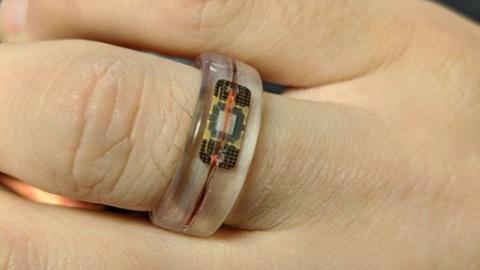
Read all about that Man dissolves credit card to make contactless ring.
Ransom email scam - How to mass extort bitcoins via spam campaign
Thursday, May 2. 2019
I've been receiving couple of these already:
Hello!
This is important information for you!
Some months ago I hacked your OS and got full access to your account one-of-my-emails@redacted
On day of hack your account one-of-my-emails@redacted has password: m7wgwpr7
So, you can change the password, yes.. Or already changed... But my malware intercepts it every time.
How I made it:
In the software of the router, through which you went online, was a vulnerability. I used it...
If you interested you can read about it: CVE-2019-1663 - a vulnerability in the web-based management interface of the Cisco routers. I just hacked this router and placed my malicious code on it. When you went online, my trojan was installed on the OS of your device.
After that, I made a full backup of your disk (I have all your address book, history of viewing sites, all files, phone numbers and addresses of all your contacts).
A month ago, I wanted to lock your device and ask for a not big amount of btc to unlock. But I looked at the sites that you regularly visit, and I was shocked by what I saw!!! I'm talk you about sites for adults.
I want to say - you are a BIG pervert. Your fantasy is shifted far away from the normal course!
And I got an idea.... I made a screenshot of the adult sites where you have fun (do you understand what it is about, huh?). After that, I made a screenshot of your joys (using the camera of your device) and glued them together. Turned out amazing! You are so spectacular!
I'm know that you would not like to show these screenshots to your friends, relatives or colleagues.
I think $748 is a very, very small amount for my silence. Besides, I have been spying on you for so long, having spent a lot of time!
Pay ONLY in Bitcoins!
Note: That is only the beginning of long rambling to make me convinced this is for real.
The good thing is, that I finally found my lost password. As stated in the scam mail, it is: m7wgwpr7
Wait a minute! Nobody should post their passwords publicly! No worries, I'll post all of mine. You can find them from https://github.com/danielmiessler/SecLists/blob/master/Passwords/Common-Credentials/10-million-password-list-top-1000000.txt As a careful Internet user, I only use passwords from that one million -list.
Also, thank you for informing me about a security flaw allowing remote code execution in my Cisco RV110W Wireless-N VPN Firewall, Cisco RV130W Wireless-N Multifunction VPN Router or Cisco RV215W Wireless-N VPN Router. I don't know exactly which one of those I have. I may need to re-read CVE-2019-1663 Detail again for details.
Good thing you mentioned, that you are capable of intercepting my attempts of changing my account password. I'm too scared to use Internet anywhere else than through my Cisco <whatever the model was> router. I'll never use my cell phone, office network or any public Wi-Fi for Internet access.
Nice job on finding the camera in one of my desktop PCs. I personally haven't found any in them yet!
Also I'm happy to know, that now somebody has backups of all my Windowses, Macs and Linuxes I use on regular basis. Including my NAS, that's nearly 20 terabytes of data! Transferring all that out of my Internet connections without me noticing anything is really a feat. Congrats on that one!
PS. Are you for real! ![]()
Going beyond recovery on a hard drive
Monday, April 15. 2019
This is where an angle grinder meets aluminium.
Angle grinding through a 3.5" hard drive case, spinning platter and controller electronic circuitry will produce enough heat and metal scraps to produce an absolutely unrecoverable hard drive. The magnetic coating containing the actual data doesn't like any kind of dirt, metal chips nor rapid heating.
Funny thing: One of the IBM drives was from era of glass platters. I had no idea about that at the time. Ear protection and noise made sure of that. Afterwards the glass platter was shattered into small pieces making the hard drive sound like a jingle bell. There was a small time slot when glass was used in drives to improve data density. Later manufacturers learned to smooth the aluminum platters beyond glass ones and abandoned the brittle materials.
Electronic equipment recycling - expect me to show up with couple pieces of dismantled electronics.
Breaking the paywall
Wednesday, April 3. 2019
Newspaper media and magazines have been suffering from digitalization for two decades. Quite few of the traditional publishers have been struggling to keep their revenue stream flowing.
Back in the 90s Internet-boom they simply went to net "because they had to". No clue what to do there, though. Paper sales were going strong, no actions required. Then the obvious happened, people stopped subscribing their paper services. Meanwhile, same people who cancelled their subscriptions, were reluctant to pay for the service on the net. Reasons were multitude: bad implementation of the site, bad implementation of subscription and payment, etc.
Past couple years the trend has been to simply block readers out of the site by erecting a paywall. That will keep the free leechers out (like me), but I'm not certain it would improve the sales. Maybe it does, because lot of the media is doing that. However, yet again the implementation is really bad. There must be enough complexity in the paywall that people like me cannot simply run something like this in Javascript console:
javascript:(function(d){d.cookie='Bhb2CdOB3V=; expires=Thu, 01 Jan 1970 00:00:00 UTC; path=/; domain=.tivi.fi;'})(document)
If you have no idea what a Javascript console is (most non-developer don't), don't worry. Here is the same thing as a bookmarklet. Concept of bookmarking sites into your browser is past gone, everybody just googles everything. Since nobody maintains bookmarks, it is not-so-user-friendly to manage bookmarks in a modern browser. However, the idea of you is to create a Javascript bookmark, aka. bookmarklet. In chrome, something like this:
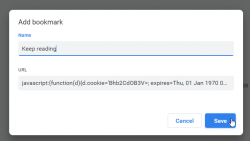
Then it is easy to just click the bookmark when you run out of reads. Reload the page and keep reading!
Finally:
Apologies for the newspaper publisher for pissing in their coffee pot. Your product is good and I have enjoyed reading the articles, it's just the price point, you're too expensive! My motivation here is to offer you a pro-bono implementation evaluation. Hint: you failed badly.
I totally expect them to improve their implementation. Also I promise not to maintain any possible hacks their future versions may include. Also I'd like to offer a piece of advice.
There are two real options you can go with:
1) implement mandatory login
or
2) keep some articles free, some behind paywall. That seems to be the only working option of keeping people like me out of your system.
Azure support for cloud-dyndns Python-script
Monday, April 1. 2019
Last year I wrote a tool to keep a server having dynamic IP-address updated into Rackspace DNS (that's free-of-charge!). See the article DynDNS updates to your Cloud DNS for details. Since the software is running in "production", I've been maintaining the thing. Production is in quotes, becuse it's not a real production-production thing. It's just something I run to make my life easier.
For a while, I've been running Azure DNS -provider and now I published the code at project's Github repo: https://github.com/HQJaTu/cloud-dyndns
Since Azure doesn't have API-keys, you need to use a service principal. Grasping the concept of service principal is tricky. For example Azure official documentation at https://docs.microsoft.com/en-us/azure/active-directory/develop/app-objects-and-service-principals fails explaining it. My own explanation for a service principal is: it is a machine user account. Yes, you can limit regular users' access in Azure, but with a service principal it is even easier. Also, a service principal cannot have 2-factor authentiation enabled for it. That's why I consider it as a machine user.
Additional:
Given the requirements, I added --ip-address-detect-public command-line argument to skip reading server's current IP-address, but probing outside world for it. The exact service is https://ipinfo.io/. Having this feature a DNS can be updated with a static IP, detected IP or probed IP. Nice!
GRID 2 Logitech G29 support
Sunday, March 17. 2019
Humble Bundle was giving away GRID 2 for free: https://www.humblebundle.com/store/grid-2. Price was right and me, as a greedy bastard, of course leeched the ware.
GRID 2 is an arcade racer. It has some level of simulation, but mostly it is targeted for regular gamers. Still, driving a racing car with a typewriter doesn't really sound sensible to me and I whipped up my G29 wheel and started the game.
Crap!
Back in 2013 they didn't support my wheel. Turns out both Codemaster's forum ([Logitech G29] Can't use wheel with GRID2 & GRID Autosport) and Steam forum ([Guide] Add G29 and G920 support to Grid Autosport (Includes Clutch and shifter)) have lengty discussion about tinkering the wheel to work. However, given the age of the game, the XML-file referenced in discussion is long gone. The information is valid.
First: This is an obvious one. Make sure you have Logitech Gaming Software installed. Danger: The wheel seems to install correcly in Windows 10, but it won't. You really really need to have the Logitech stuff installed also. I got version 9.02 from https://support.logitech.com/en_us/product/g29-driving-force/downloads.
Second: The XML-file everybody is talking about is here: lg_g27.xml. Place it into steamapps\common\grid 2\input\ (suggest backing up the original file first!) and then selecting Direct Input Device from game controller options. This enables choosing of Preset <lg_g29> and further tailoring controller settings to your own liking.
Happy racing!
StackExchange flair received
Monday, March 11. 2019
Whoa! I finally hit the long awaited 200 point mark in Stack Overflow. The good part about that is, Stack Exchange starts publishing a public badge they'll call "flair". They do this to make it possible for me to publicly boast about my prowess. To get some public boasting going on, my flair looks like this:

All of you Peeping Toms out there, I'll save you couple keystrokes of googling: My  public user profile is at https://stackexchange.com/users/1684769/hqjatu
public user profile is at https://stackexchange.com/users/1684769/hqjatu
Blog improvement: Responsive theme
Sunday, March 10. 2019
Going back in the memory lane, back in 2009 Mr. Wroblewski coined up a term "mobile first". At the time pocket computers, or not-so smart phones where a new thing, but booming heavily. First iPad wasn't out there and tablet computing was merely a curiosity. Still Mr. Wroblewski envisioned a future, where most of the web browsing would be done with a mobile device.
To state the obvious: Mr. Wroblewski was not wrong in his statement. His future vision started becoming a reality in April 2015 when Google as the #1 authority on website content, announced they would be demoting pages not being mobile user friendly. In November 2016 Google announced Mobile-first Indexing initiative. In March 2018 they followed up on that and started rolling out mobile-first indexing.
Rougly past 4-5 years this blog of mine has been suffering from this demotion and I really started taking the hit in 2018. Originally I chose this paper-style theme for this blog when I first created it in 2013, and it has been unchanged ever since. Not doing anything about it was an obvious mistake on my part. However, it took a while for Serendipity theme repository to even have properly implemented responsive design themes, so it was impossible for me to change the theme. Still, why would I even want to change the way my blog looks like!
Finally: I chose to improve the theme by making it responsive. In practice, I bootstrapped it with Bootstrap. This is a super-cool project originally created by few guys at Twitter. Read the Wikipedia article about that at https://en.wikipedia.org/wiki/Bootstrap_(front-end_framework). Getting to understand the 12 column grid system takes a while, but when you do the groundwork of arranging page content to rows and columns and realize that you can get six different chunks of display real estate by 1, 2, 3, 4, 6 and 12 columns depending on user's screen size, the results will be amazing! Most of this trickery doesn't even require any JavaScript to run. Adding floating navigation bars and such will require JS, but majority of the goodies work fully on bare HTML/CSS.
So, this is where I stared my journey with:
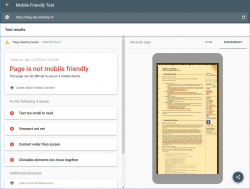
Google Mobile-Friendly Test spits out a lot of grievance from my blog.
This is the result with this new theme applied:
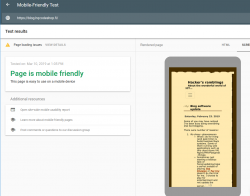
Oh yeah! Now GoogleBot should be much happier with this one. For those of you who want to play around with this, just go make the browser window very narrow and see the point where screen breaks and drops the right side menu off. To access the goodies on right side menu, a hamburger menu will be added to the top of the page.
GoogleBot tester isn't completely happy about my page, there are some load errors. However, I'm not sure exactly what the load errors are as they're labeled "other". Tons of people in The Net are suffering the same. Warning says:
Page partially loaded
Not all page resources could be loaded. This can affect how Google sees and understands your page. Fix availability problems for any resources that can affect how Google understands your page.
Based on lot of other people's comments found in web, the "errors" are merely warnings and they may or may not reduce the page rank. I'm agreeing with some people commenting, that the test Googlebot smartphone client is using super-short timeouts forcing people to optimize their websites to do as little loading as fast as possible.
The standard disclaimer applies:
If any of you think, that this theme doesn't work properly or I did something wrong. Drop me a comment or go to my Github fork at https://github.com/HQJaTu/additional_themes/tree/brownpaper-r2 and create a new pull request. I'm more than interested in keeping this new theme running optimally.
Blog software update
Saturday, February 23. 2019
Some of you may have noticed I've been busy doing everything else but blogging.
There were number of reasons:
- No shoes -phenomenon
- What I do for living (and past-time) is build/maintain/hack systems. Some of them running web applications such as this cloud Azure VM Nginx/PHP/PostgreSQL -thingie.
- Sometimes just starting a tedious task of fixing/updating/repairing a server instead of playing The Division or Far Cry doesn't do the trick for me. I choose to play for entertainment and not update the server.

- Ref.: The Cobbler's children have no shoes
- PHP 5.6 support EOL
- See https://secure.php.net/supported-versions.php for details
- This blog has been running on 5.6 for years and to get that updated, I had to re-asses configurations to get 7.2 running. Not an easy task, but had to be done to go forward.
- Serendipity 2.1 upgrade
- Most of you have never realized, I wouldn't touch Wordpress with a 9 foot pole. This blog runs on Serendipity (aka s9y).
- Previous version of S9y 2.0 wouldn't run correctly with PHP 7.2, so I had to go for this upgrade too.
- See https://docs.s9y.org/ for details.
- Mobile template
- This blog gets reasonable Page Rank from Google, but it really suffers from not being very good when displayed on a mobile device.
- See #1 above. This is what I do for living. It should be not a complicated task to strap Bootstrap boot on top of the theme.
- See http://blog.s9y.org/index.php?user_template=additional_themes/brownpaper
What hasn't changed: I'm still in Microsoft Azure, running CentOS 7.
The mobile version of Brown Paper is still under work in my lab VM, but it will be out soon. I promise! ![]()
Fedora dhclient broken
Monday, December 10. 2018
I'm not a huge fan of NetworkManager. Since I am a fan of many RedHat products, it creates a nice conflict. They develop it, so it is pre-installed in all of RedHat's Linuxes. Luckily its very easy to yank off and replace with something that actually works and is suitable for server computing.
Also, a third player exists in the Linux networking setup -scene. systemd-networkd (https://www.freedesktop.org/software/systemd/man/systemd-networkd.html) does exactly the same as NetworkManager or classic network-scripts would do. It is the newcomer, but since everybody's box already has systemd, using it to run your networking makes sense to some.
I don't know exactly when, but at some point Fedora simply abandoned all the classic ways of doing networking. I know for a fact, that in Fedora 26 ISC's dhclient worked ok, but looks like around the time of 26 release, they simply broke it. Now we're at 29 and it has the same code as 28 did. Since almost nobody uses classic networking, this bug went unnoticed for a while. There is a bug in RedHat's Bugzilla which looks similar to what I'm experiencing: Bug 1314203 - dhclient establishes a lease on the explicitly specified interface, but then endlessly retries old leases on other interfaces, but looks like it didn't get any attention. To make this bug even more difficult to spot, you need to have multiple network interfaces in your machine for this problem to even exist. Most people don't, and looks like those who do, aren't running dhclient.
The issue, in detail, is following:
When run ifup eno1, no IP-address will be issued by my ISP for that interface.
When running dhclient in diagnostics mode, with following command:
/sbin/dhclient -1 -d -pf /run/dhclient-eno1.pid -H myPCame eno1
output will be:
Internet Systems Consortium DHCP Client 4.3.6
Copyright 2004-2017 Internet Systems Consortium.
All rights reserved.
For info, please visit https://www.isc.org/software/dhcp/
Listening on LPF/enp3s0f1/90:e2:ba:00:00:01
Sending on LPF/enp3s0f1/90:e2:ba:00:00:01
Listening on LPF/eno1/60:a4:4c:00:00:01
Sending on LPF/eno1/60:a4:4c:00:00:01
Listening on LPF/enp3s0f0/90:e2:ba:00:00:02
Sending on LPF/enp3s0f0/90:e2:ba:00:00:02
Sending on Socket/fallback
DHCPDISCOVER on enp3s0f1 to 255.255.255.255 port 67 interval 3 (xid=0x90249a1f)
DHCPREQUEST on eno1 to 255.255.255.255 port 67 (xid=0xe612e570)
DHCPDISCOVER on enp3s0f0 to 255.255.255.255 port 67 interval 5 (xid=0xb568cb15)
DHCPACK from 62.248.219.2 (xid=0xe612e570)
DHCPREQUEST on enp3s0f0 to 255.255.255.255 port 67 (xid=0xb568cb15)
DHCPOFFER from 84.249.192.3
DHCPACK from 84.249.192.3 (xid=0xb568cb15)
DHCPDISCOVER on enp3s0f1 to 255.255.255.255 port 67 interval
Notice how DHCP-client was requested on network interface eno1, but it is actually run for all there are. For me, this is a real problem, so I spent a while on it. Bug report is at Bug 1657848 - dhclient ignores given interface and it contains my patch:
--- ../dhcp-4.3.6/common/discover.c 2018-12-10 16:14:50.983316937 +0200
+++ common/discover.c 2018-12-10 15:20:12.825557954 +0200
@@ -587,7 +587,7 @@
state == DISCOVER_REQUESTED))
ir = 0;
else if (state == DISCOVER_UNCONFIGURED)
- ir = INTERFACE_REQUESTED | INTERFACE_AUTOMATIC;
+ ir = INTERFACE_AUTOMATIC;
else {
ir = INTERFACE_REQUESTED;
if (state == DISCOVER_RELAY && local_family == AF_INET) {
My fix is to break the functionality of dhclient. If you don't specify an interface for dhclient to run on, it will run on all. To me (or my network-scripts) that won't make any sense, so I'm choosing to run only on specified interfaces, or interface in my case. This patch when applied and compiled to a binary will fully fix the problem.
Windows 10 with Microsoft's OpenSSH
Sunday, December 2. 2018
Without thinking it too much, I just went for a SSH-connection on a Windows 10 box with the way it's typically done:
ssh -i .ssh/id_nistp521 user@linux-box
When the result was not a private key passphrase question, but a: Bad owner or permissions on .ssh/config, I started thinking about it. What! What? Why! It worked earlier, why won't it anymore?
For the record:
I am an avid Cygwin user. So, I get a very very Linuxish experience also on my Windows-boxes. So, don't be confused with the rest of the story. This is on a Windows 10, even if it doesn't appear to be so.
Back to the failure. I started poking around the permissions. SSH-clients are picky on private key permissions (also config file), so I thought that something was going on. Doing a ls -l:
-rw------- 1 jari None 547 Nov 12 17:25 config
-rw------- 1 jari None 444 Jul 15 2017 id_nistp521
Nope. Nothing wrong with that. Still, something HAD to be wrong, as this wasn't acceptable for the client. Doing a which ssh gave it away. I was expecting to see /usr/bin/ssh, not /cygdrive/c/Windows/System32/OpenSSH/ssh!!
So, who put an OpenSSH client to my Windows-directory? Why? When? What kind of sorcery is that? Environment variables:
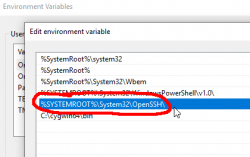
Yes, there is a PATH-entry for OpenSSH before Cygwin. In the directory, there is a full set of OpenSSH-tools:

Version is 7.6:
OpenSSH_for_Windows_7.6p1, LibreSSL 2.6.4
The expected version in Cygwin is 7.9:
OpenSSH_7.9p1, OpenSSL 1.0.2p 14 Aug 2018
So, to fix this, I yanked the PATH-entry away. Now my SSH-connections worked as expected.
Little bit of googling around landed me on an article OpenSSH in Windows 10! in MSDN blogs. This is on January 2018 and apparently this stuff landed on my Windows in April update (build 1803). Also in article What’s new for the Command Line in Windows 10 version 1803, I found out that also tar and curl were added.
Ultimately this is a good thing. Now that I know this stuff is there as default, there is no need to go load a PuTTY or something for a random SSH-thing you just want to get fixed on a remote box.
PS4 controller in a PC
Wednesday, November 14. 2018
Lately, I've been playing Mudrunner: Spintires a lot. That's a really weird game about logging machinery and mud. For some strange reason I find hauling logs from a lake through mud really entertaining. Why logs are located a "lake" is beyond me.
During the gameplay, player needs to operate number of different heavy machinery. This involves driving a skidder, a heavy truck or operating a crane to get the logs loaded. I tried doing that with a traditional mouse and keyboard config. I kinda managed to do it, but anybody who has driven a real car or truck or flown an airplane using only a keyboard knows, it's very tricky. Then I got a hint, that a Playstation 4 controller is really good with that game.
A-haa! All I need to do is hook up my PS4-controller into my PC using ... well... dunno. As Google search engine is a good friend, I found a project DS4Windows from Github https://github.com/Ryochan7/DS4Windows. It will convert a PS4-controller into an Xbox controller, which will work perfectly with most games.
Just hokk up an USB-cable to the controller, run the software, and:

You're done! It really is that simple. Now spinning tires in mud is much much more enjoyable!
iOS Voicemail number
Tuesday, November 6. 2018
The other day I realized, that my mobile subscription has a voicemail. Since its a corporate one, I really cannot control it much, it just ... well ... is.
This existence of voicemail became evident for a simple reason. Somebody left me a message there. Ufff! Why! Personally I hate those 70s relics. If you cannot get a hold of me, just send a SMS or an email! ... People... They just don't get it.
So. I had an easy task, go listen the message. In an iPhone, there is a Voicemail menu:

Tapping the "Call Voicemail" does absolutely nothing. Eventually I did find the voicemail number from my subscription paperworks. That is, if I really was interested in the message, but I wasn't. Being a geek, I wanted to get my iPhone to do what the button caption says. To Call Voicemail.
Apparently that is something my Telco should fix. Or, that's how its done in the Big World. No such joy for me. After a good while of googling around, I found bunch of codes, which actually didn't either work, or do anything useful on an iPhone. Finally, I bumped into an ancient Apple community discussion with topic Q: iphone 5 change/add voicemail number? This user had been instructed the following:
I have just been in contact with Orange regarding this they advised to dial:
*5005*86*123#
This will set the voicemail number to 123 (orange) so hopefully (i've not tested) you can just put your voicemail number inplace of 123!
Yes! Doing a *5005*86*<my voicemail number here># does the trick for my iPhone 8 running iOS 12.1.
While at it, I googled more and found article iPhone codes from the same era.
| Code | Description |
## 5005*86 # |
Erases the Voice Mail number (iOS specific) |
*# 5005*86 # or *# 61 # |
Displays the Voice Mail number (iOS specific) |
* 5005*86 * <a number> # |
Sets the voicemail number (iOS specific) |
*# 06 # |
Display IMEI number, see: https://en.wikipedia.org/wiki/International_Mobile_Equipment_Identity |
*# 30 # |
Caller-ID display check (on / off), see https://en.wikipedia.org/wiki/Caller_ID#Caller_ID_blocking |
*# 43 # |
Check if call waiting is activated |
*# 21 # |
Displays any call forwarding settings enabled |
*# 33 # |
Displays call barring settings, see https://en.wikipedia.org/wiki/Unstructured_Supplementary_Service_Data |
* 004 # |
Enable voicemail |
# 004 # |
Disable voicemail |
For a complete list of generic mobile phone Unstructured Supplementary Service Data (USSD), or "Quick Codes" or "Feature codes" see Wikipedia article https://en.wikipedia.org/wiki/Unstructured_Supplementary_Service_Data#Code_table.
Formula 1 messing with Apps
Wednesday, October 24. 2018
As a Formula 1 fan, while watching a F1 Grad Prix, I've been using real-time information feeds on https://www.formula1.com/en/f1-live.html pretty much since it was released. If memory serves me correct, that must have been around season 2008. After getting my first iPad (yes, the 1st gen one) in 2011, I went for the beautiful paid App by Soft Pauer flooding me with all kinds of information during the race. I assumed, that I had all the same information available as the TV-commentators.
In 2014 something happened. The app was same, but the publisher changed into Formula One Digital Media Limited, making it not a 3rd party software, but an official F1-product. At the same time, the free timing on the website was removed, causing a lot of commotion, as an example Why did FIA dumb-down the Live Timing on F1.com? Also, in a review (Official F1 Live Timing App 2014 reviewed), the paid app was considered very pricey and not worth the value. Years 2015 onwards, made it evident, that in loving care of the Formula One Group, they improved the app adding content, more content, improving the value and finally a TV to it. It was possible to actually watch the race via the app. All this ultimately resulted in a must-have app for every F1 fan.
This year, for Singapore weekend, they did something immensly stupid.
ARGH!
Did they really think nobody would notice? To put it shortly, their change was a drastical one. I ditched the new timing app after 5 minutes of failing attempts to get anything useful out of it. The people doing the design for that piece of sofware completely dropped the ball. Thy simply whipped up "something". Probably in their bright minds it was the same thing than before, it kinda looked the same, right. Obviously, they had zero idea what any form of motor racing is about. What information would be useful to anybody specatating a motor racing event was completely out of their grasp. They just published this change to App Store and went on happily.
Guess what will happen, when you take an expensive piece of yearly subscribed software and remove all the value from it. You will, but the authors of the software didn't.
IT MAKES PEOPLE MAD!
It didn't take too long (next race, to be exact), when they silently dropped the timing feature and released the old app as a spin-off titled F1 Live Timing. Obviously informing any paying customers of such a thing wasn't very high on their list of priorities. In their official statement they went for the official mumbo-jumbo: "The launch of our new F1 app didn't quite live up to your expectations, and live timing didn't deliver the great mobile F1 experience you previously enjoyed." By googling, I found tons of articles like Formula 1 makes old live timing app available again after problems.
As a friendly person, I'll offer my list of things to remember for FOM personnel in charge of those apps:
- Do not annoy paying customers. They won't pay much longer.
- If you do annoy paying customers, make sure they won't be really annoyed. They will for sure stop paying.
- If you make your paying customers mad, have the courtesy of apologizing about that.
- Also, make sure all of your paying customers know about new relevant apps, which are meant to fix your own failures.
- Improve on software design. Hire somebody who actually follows the sport to the design and testing teams.
Thank you.
